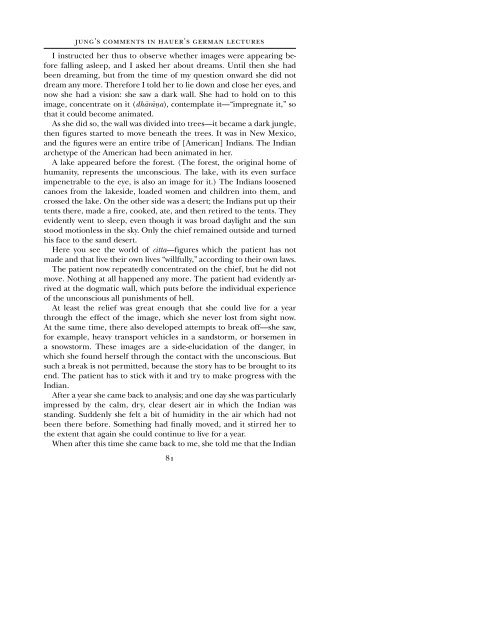CG JUNG - Countryside Anarchist
CG JUNG - Countryside Anarchist
CG JUNG - Countryside Anarchist
You also want an ePaper? Increase the reach of your titles
YUMPU automatically turns print PDFs into web optimized ePapers that Google loves.
<strong>JUNG</strong>'S COMMENTS IN HAUER'S GERMAN LECTURES<br />
I instructed her thus to observe whether images were appearing before<br />
falling asleep, and I asked her about dreams. Until then she had<br />
been dreaming, but from the time of my question onward she did not<br />
dream any more. Therefore I told her to lie down and close her eyes, and<br />
now she had a vision: she saw a dark wall. She had to hold on to this<br />
image, concentrate on it (dhvrvõa), contemplate it—“impregnate it,” so<br />
that it could become animated.<br />
As she did so, the wall was divided into trees—it became a dark jungle,<br />
then figures started to move beneath the trees. It was in New Mexico,<br />
and the figures were an entire tribe of [American] Indians. The Indian<br />
archetype of the American had been animated in her.<br />
A lake appeared before the forest. (The forest, the original home of<br />
humanity, represents the unconscious. The lake, with its even surface<br />
impenetrable to the eye, is also an image for it.) The Indians loosened<br />
canoes from the lakeside, loaded women and children into them, and<br />
crossed the lake. On the other side was a desert; the Indians put up their<br />
tents there, made a fire, cooked, ate, and then retired to the tents. They<br />
evidently went to sleep, even though it was broad daylight and the sun<br />
stood motionless in the sky. Only the chief remained outside and turned<br />
his face to the sand desert.<br />
Here you see the world of citta—figures which the patient has not<br />
made and that live their own lives “willfully,” according to their own laws.<br />
The patient now repeatedly concentrated on the chief, but he did not<br />
move. Nothing at all happened any more. The patient had evidently arrived<br />
at the dogmatic wall, which puts before the individual experience<br />
of the unconscious all punishments of hell.<br />
At least the relief was great enough that she could live for a year<br />
through the effect of the image, which she never lost from sight now.<br />
At the same time, there also developed attempts to break off—she saw,<br />
for example, heavy transport vehicles in a sandstorm, or horsemen in<br />
a snowstorm. These images are a side-elucidation of the danger, in<br />
which she found herself through the contact with the unconscious. But<br />
such a break is not permitted, because the story has to be brought to its<br />
end. The patient has to stick with it and try to make progress with the<br />
Indian.<br />
After a year she came back to analysis; and one day she was particularly<br />
impressed by the calm, dry, clear desert air in which the Indian was<br />
standing. Suddenly she felt a bit of humidity in the air which had not<br />
been there before. Something had finally moved, and it stirred her to<br />
the extent that again she could continue to live for a year.<br />
When after this time she came back to me, she told me that the Indian<br />
81


